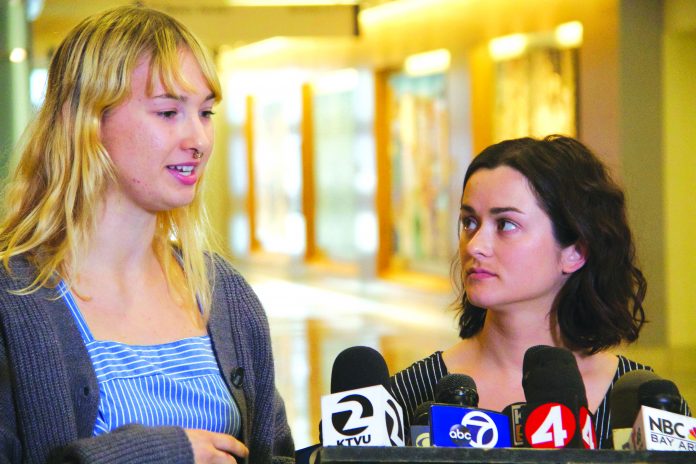Brynn Ota-Matthews and Gabriella Gaus were in the inflatable obstacle course at the Gilroy Garlic Festival when a shooter opened fire on the crowd.
The two friends from Santa Cruz ran from the play structure to the festival parking lot, and only then realized they’d both been injured. They continued to run for “what felt like forever,” until a stranger got the women into his car and drove them to St. Louise Regional Hospital about three miles away.
“We didn’t ever look back,” said Gaus. She said there was a moment when she thought the noise of the gun was some kind of joke, but once she saw the shooter, her body told her to run. “It took a really long time for me to register—I heard it, so I knew that we were supposed to run.”
Gaus had been grazed by several bullets across her back, and was treated and released. Ota-Matthews had been shot in the back and said she will now live her life with a .22-caliber bullet in her liver. Ota-Matthews was transferred to Santa Clara Valley Medical Center from Gilroy and was discharged Aug. 1. That afternoon, the two women held a press conference in San Jose to give updates on their health, thank first responders and recount what had happened.
The first person Gaus thanked was a man named John—at least she thought that was his name. He was the one who had picked the two up in his car and driven them to the hospital. “I didn’t feel safe until I was fully in a car,” said Gaus.
She credited “John” with getting them help so quickly, making them some of the first victims of the shooting to arrive at St. Louise.
The two women are friends who worked together at the Bantam restaurant, 1010 Fair Ave., on the westside of Santa Cruz. Neither Ota-Matthews, 23, nor Gaus, 26, have health insurance.
They said they attended the festival with a group of five friends, including Ota-Matthews’ boyfriend, who had managed to find the two in the chaotic crowd.
The same images live in both of their minds: escaping the inflatable jungle gym, running through the crowd of people, Gaus screaming at the realization she had been hit. “It was just the most terrifying place for us to be,” said Ota-Matthews.
Ota-Matthews and Gaus considered themselves lucky; at the press conference they took a moment to acknowledge those that had lost their lives at the festival, 6-year-old Stephen Romero, 13-year-old Keyla Salazar and 25-year-old Trevor Irby.
The women struggled to understand the gunman’s motives and what led to the moment they realized they were being shot at. Gaus remembered looking the gunman in the eye seconds before the shots became distinguishable.
“Like, I remember looking at him and just like staring at him until he started rapid firing. Shot once, pause and then rapid fire,” Gaus told the press conference. “So I remember in between those few seconds just staring at him, and he was like a trained military professional.”
The photos released of that man, later identified as 19-year-old Santino Legan, seemed in sharp contrast to the memories of Gaus and Ota-Matthews.
The women said neither of them have fully grasped how this will change their day-to-day life. Gaus was discharged from the hospital the night of the shooting, but had barely left her house four days later.
“I sound really bleak and sad, but like I hope that I feel a sense of general trust towards humanity because right now I really don’t. I feel like paranoid when I leave my house, I don’t know who I can trust. Even like going to the grocery store, people are looking at me – and, like, you don’t know I’m a victim because my clothes cover my wounds and like whatever,” said Gaus. “But it just feels like really sickening to me every time I leave my house. So, I think someday I hope to feel really positive, to have a positive outlook. But right now, it’s not really there.”
For Ota-Matthews it’s her injury that will remind her everyday what she’s been through. The bullet didn’t hit any other vital organs, but it will remain inside Ota-Matthews’ liver for the foreseeable future.
“Every time I’m awake it’s just always in the back there. Sometimes, like happy feelings, like I’m so happy that we did this and I’m so happy that we found this person and he helped us, and sometimes it’s terror,” said Ota-Matthews. “I just see him—walking into the festival.”








